How to Setup a Monero Wallet to Send and Receive Funds Anonymously - Windows Guide

Monero has been making headlines recently after being adopted by Alphabay and Oasis darknet markets. Their value has skyrocketed.
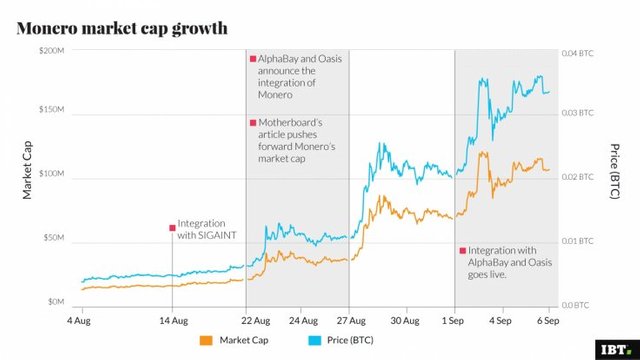
Photo source: IBTimes.co.uk
So I decided to kick the wheels on this coin and see what all the hype is about. The first task was to just create a wallet on my Windows PC and receive some Monero to it. What I found out was Monero is not very easy to use at the moment and although they do offer Windows downloads they are actually DOS command line tools.
I'm going to tell you right now. Installing a full node and running a wallet locally with Monero on Windows was a somewhat painful experience compared to other crypto-currencies. If you just want to get a wallet quick and easy the web wallet is the best solution by far for a quick and easy experience. If you don't have a lot of time and aren't comfortable using a DOS command line then head over to MyMonero.com and create a free web wallet. Otherwise let's get into it:
Downloading and Installing Monero on Windows
To download Monero for Windows go to GetMonero.org - Downloads Page and download either the Windows 64bit or Windows 32bit version. You should download a zip file that will need to be extracted. I extracted mine to e:\cryptocurrencies\monero.
Now you also need to download the existing Blockchain to catch up you could just run bitmonerod.exe and let it download the Blockchain but it's quicker if you just download the raw Monero Blockchain here and save it inside your Monero folder.
Open a command prompt window by pressing the Windows start button then type 'cmd' (no quotes) and press enter. You should now see a DOS command line window. Navigate to your Monero directory for me it is 'cd e:\cryptocurrencies\monero' your location will be different depending on where you extracted your files to. If you use the 'dir' command here you should see a directory listing like the one below:
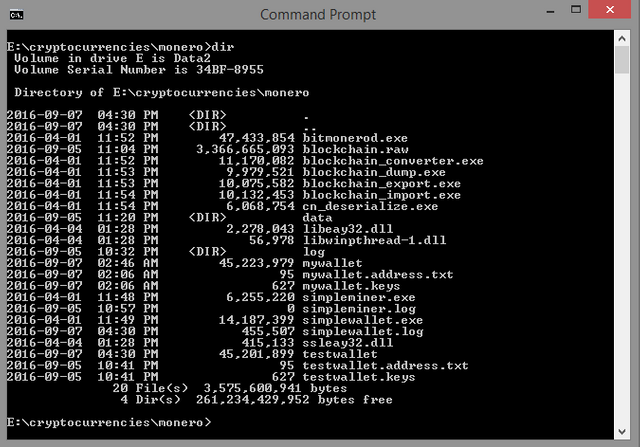
I personally do not use the default data directory 'C:\ProgramData\BitMonero' I simply do not have enough room on my C: drive to store all the blockchains I run. That is why I will be using the --data-dir flag on my commands. If you have plenty of spare room on your C: drive then you do not need to use the --data-dir flag. To give you an idea of the storage requirements the raw blockchain is about 3.2GB right now and once you've imported that blockchain it will take up 10GB right now but keep growing.
Importing the Blockchain
Enter the command 'blockchain_import.exe --input-file blockchain.raw --data-dir blockchain' The data-dir can be any directory you wish, it's where the blockchain will be extracted to and grow. You should see something likes this on your screen:
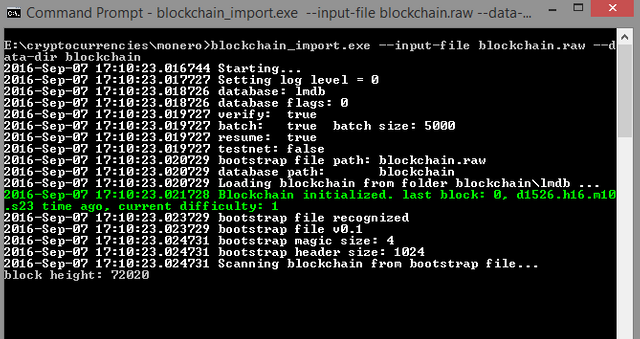
It's going to count all the block heights and then you will begin to see something like this:
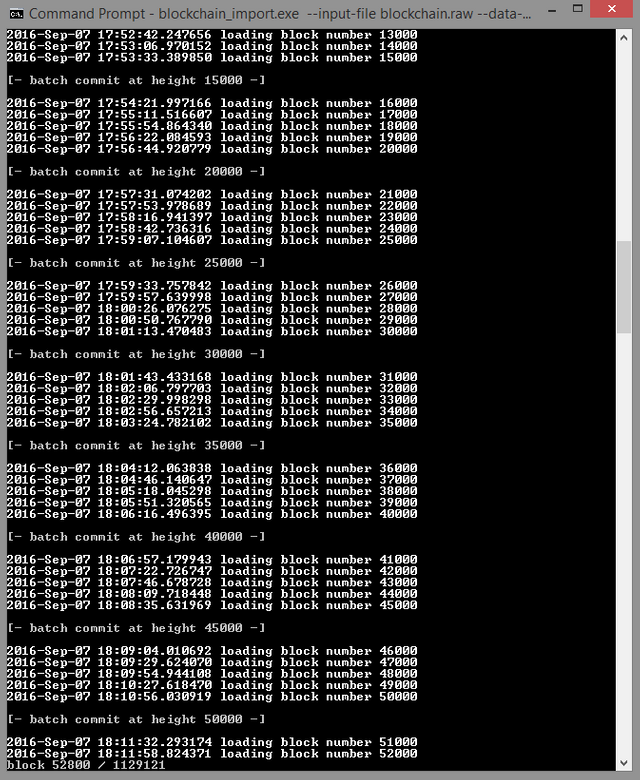
This process lasted overnight for myself, it was a very lengthy process. Don't even bother standing by while it catches up with the entire blockchain. This is probably the biggest reason to just use the web wallet mentioned above.
Starting Monero Core
When the process finally finishes it will exit on it's own. You are now ready to launch the Monero core to stay in sync with the blockchain and execute transactions. Enter the command 'bitmonerod.exe --data-dir blockchain' and you should be greated to screen like this one. It will tell you that you are ready to start the simplewallet.
Running Monero Simple Wallet
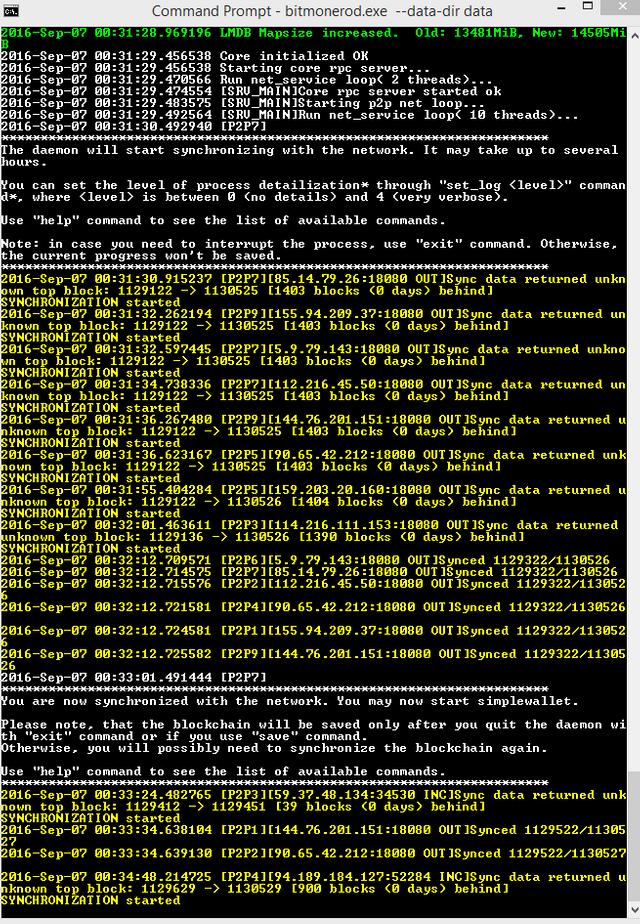
Now you need to keep this current window open and running while you open another command prompt window. To do this easily just right click on the command prompt icon for the running window on the task bar at the bottom of your screen and select 'command prompt'. It should open up a new command prompt window for you. You'll need to navigate to your monero directory again 'cd e:\cryptocurrencies\monero' is where mine was.
You can now run the command 'simplewallet.exe' it will prompt you for a wallet name this can be anything you want it's just a name you have for your wallet. I used 'mymonero', press enter and it will ask for a password, you don't have to use a password but you can if you want to keep your wallet secure. It will then prompt you for which language you would like to use. Pick the number that corresponds with your language of choice and press enter. You are all done. It has now created a brand new wallet for you with a new address.
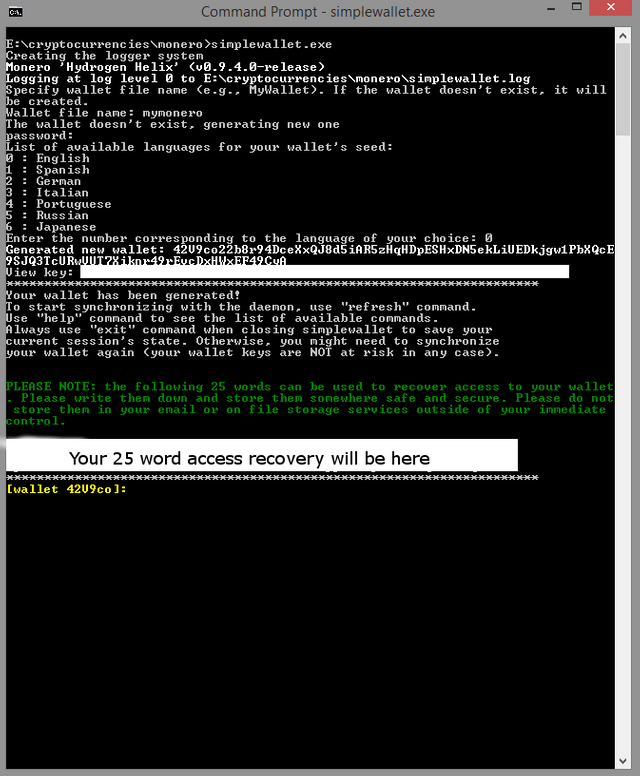
You can type help then press enter for a full list of wallet commands that you can use to check your balance, send and receive Monero coins etc. Here is a screen capture of the help screen:
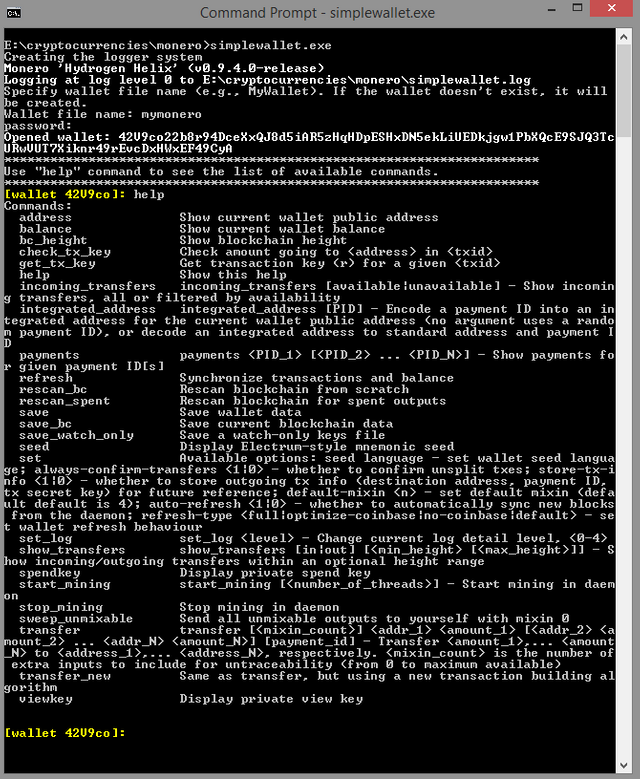
Commands:
address Show current wallet public address
balance Show current wallet balance
bc_height Show blockchain height
check_tx_key Check amount going to <address> in <txid>
get_tx_key Get transaction key (r) for a given <txid>
help Show this help
incoming_transfers incoming_transfers [available|unavailable] - Show incomin
g transfers, all or filtered by availability
integrated_address integrated_address [PID] - Encode a payment ID into an in
tegrated address for the current wallet public address (no argument uses a rando
m payment ID), or decode an integrated address to standard address and payment I
D
payments payments <PID_1> [<PID_2> ... <PID_N>] - Show payments fo
r given payment ID[s]
refresh Synchronize transactions and balance
rescan_bc Rescan blockchain from scratch
rescan_spent Rescan blockchain for spent outputs
save Save wallet data
save_bc Save current blockchain data
save_watch_only Save a watch-only keys file
seed Display Electrum-style mnemonic seed
set Available options: seed language - set wallet seed langua
ge; always-confirm-transfers <1|0> - whether to confirm unsplit txes; store-tx-i
nfo <1|0> - whether to store outgoing tx info (destination address, payment ID,
tx secret key) for future reference; default-mixin <n> - set default mixin (defa
ult default is 4); auto-refresh <1|0> - whether to automatically sync new blocks
from the daemon; refresh-type <full|optimize-coinbase|no-coinbase|default> - se
t wallet refresh behaviour
set_log set_log <level> - Change current log detail level, <0-4>
show_transfers show_transfers [in|out] [<min_height> [<max_height>]] - S
how incoming/outgoing transfers within an optional height range
spendkey Display private spend key
start_mining start_mining [<number_of_threads>] - Start mining in daem
on
stop_mining Stop mining in daemon
sweep_unmixable Send all unmixable outputs to yourself with mixin 0
transfer transfer [<mixin_count>] <addr_1> <amount_1> [<addr_2> <a
mount_2> ... <addr_N> <amount_N>] [payment_id] - Transfer <amount_1>,... <amount
_N> to <address_1>,... <address_N>, respectively. <mixin_count> is the number of
extra inputs to include for untraceability (from 0 to maximum available)
transfer_new Same as transfer, but using a new transaction building al
gorithm
viewkey Display private view key

Thank you, I've learnt so much. I appreciate it.
Very interesting. I didn't know it
hmm, now I'm wondering why they didn't fork an existing Qt based wallet.. but command line interface is fun nonetheless
I'm guessing that wasn't compatible with their goal of it being anonymous?
right, makes sense, but I was referring to the wallet client and not the protocol or network.. they could just use the Qt frontend code to provide an easy GUI but modify everything else heavily to fit their logic that makes monero monero
Because it's not a fork. Monero isn't "based" on anything. It's independent from Bitcoin in every way, and has no real similarities. Thus a QT wallet would mean a completely new one.
I meant to say just taking the Qt frontend code from an existing wallet client, so that there will be a nice GUI, but if there is no clear MVC division, I guess just writing a GUI from scratch would be quicker than adopting code from another crypto project.
Great Guide man ! Please Keep up with the good Work ! I'm consider Mining Monero via GPU , you think the price will go up from here onwards after a year of nearly no activity ?
I didn't see too much of an advantage between cpu and gpu mining in my experiments. Maybe your hardware will fare better than mine. I'm seeing good results mining LBRY on hardware right now.
I think Monero will be a bit longer but huge rewards. I think the GUI client being released will be a big bump and then as we see ransomware start to adopt Monero the value will rise as well.
great tutorial, it's still far too complicated for this crypto newbie though.
The instructions are pretty clear (relatively speaking).
Looks worse than it is, but then again I've been using DOS and the command line since 1981 or there about. So I guess YMMV.
Honestly unless you are doing it as a hobby or to write a tutorial I would just use the web wallet for now. Good news is they have a beta GUI coming out very soon. I'm expecting to see a rise in value when the wallet lands.
to be honest I'm just playing with about $59 for now trying to get used to poloniex and work it all out (not doing to bad it was $47 a few days ago, although im not sure how much of that is the miniscule trades I've done and how much is because of the rise in BTC) all my trades are happening there so there is no need for a monero wallet just yet.